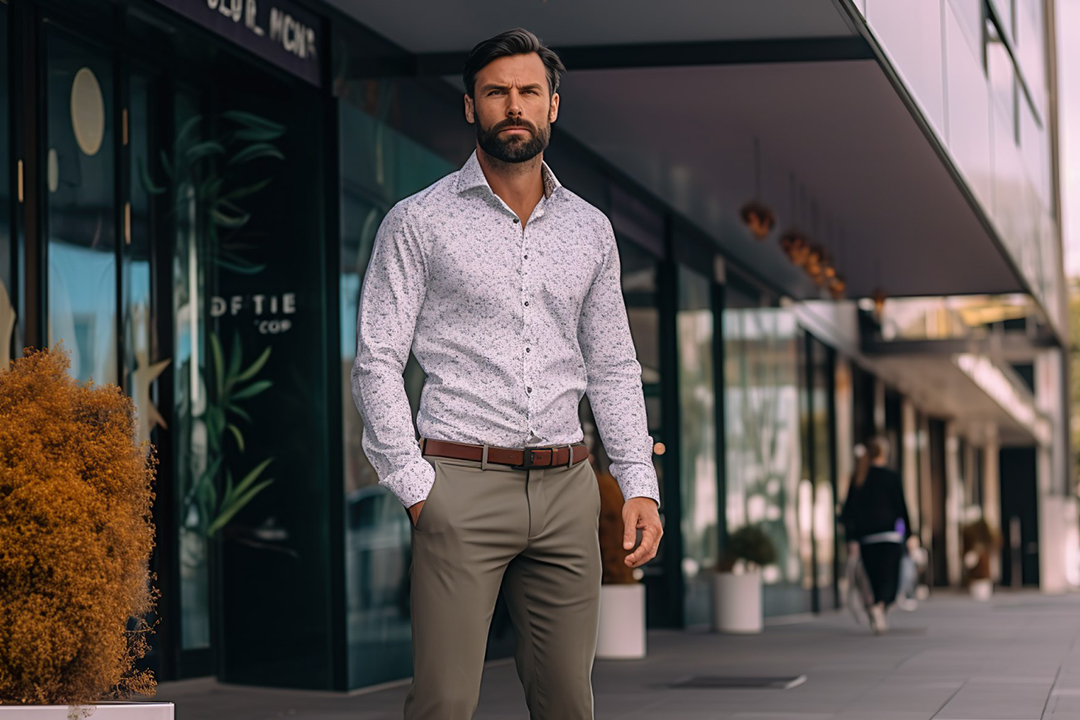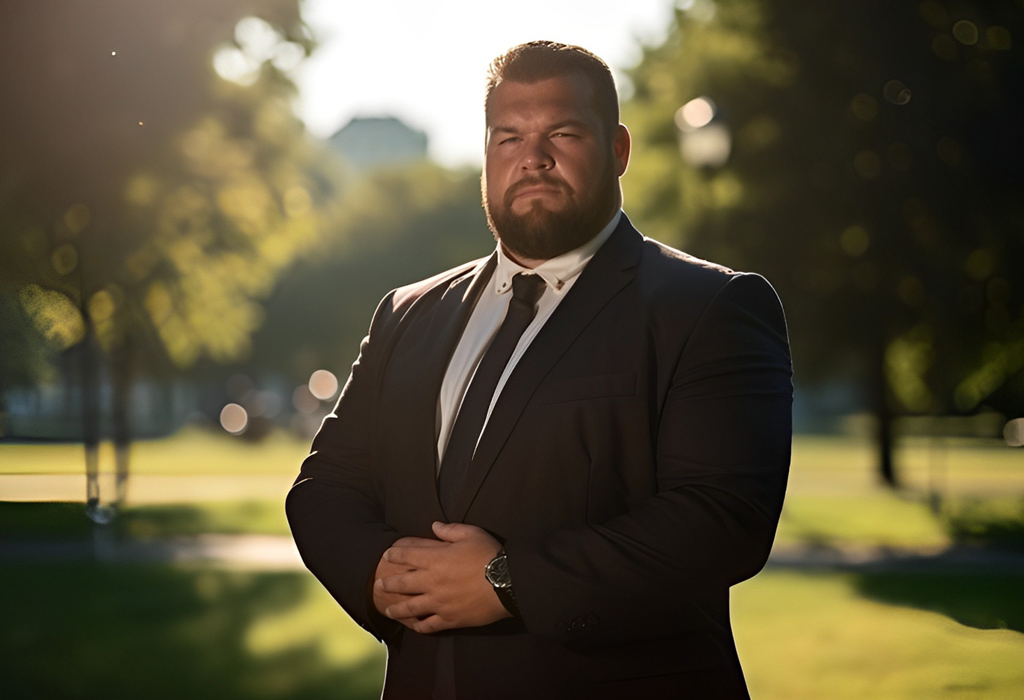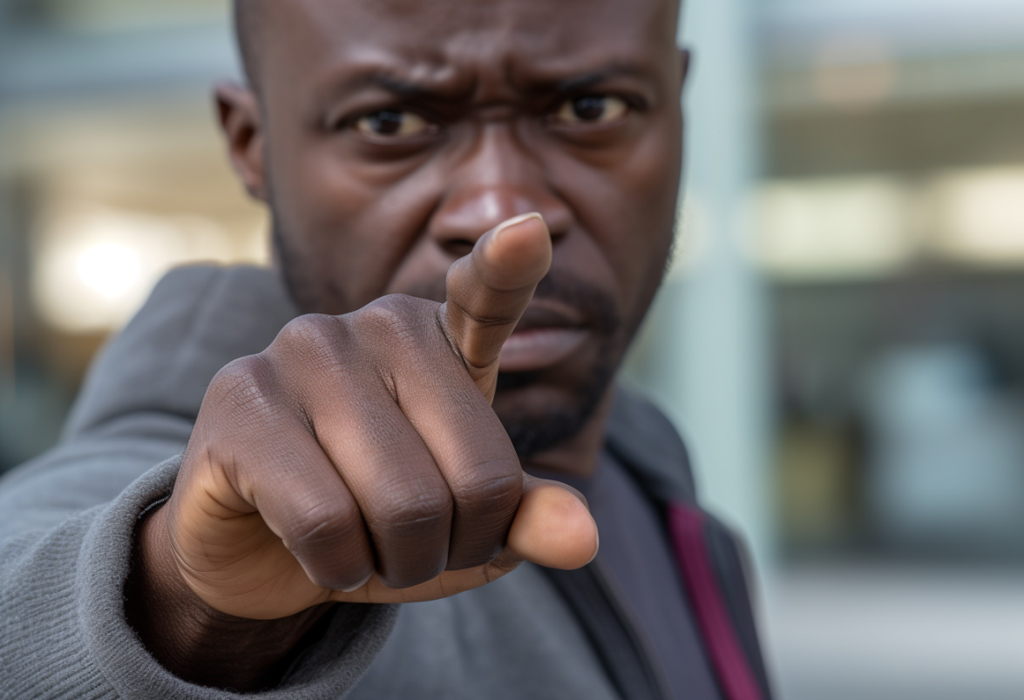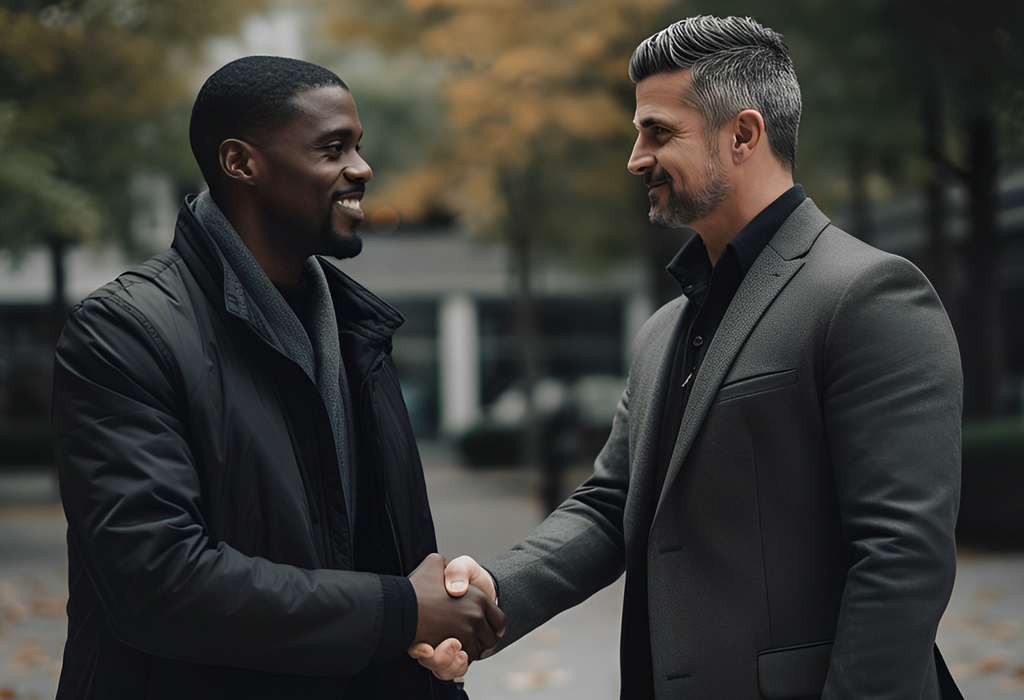A Man and Body Language | What You Say Without Opening Your Mouth
January 09, 2024BruceDayne
One of the reasons so much writing gets devoted to fashion is that it's a silent language.
Without saying a word, your outfit speaks — it tells people who you are, what your values are, and in most settings what your social status is. (Like any language, of course, it can also be lied in, but the communication is still happening whether it's true or not!)
Go a level deeper, however, and you'll find that we're speaking to each other on a visual level regardless of what clothes we're wearing. Body language is something that could work stark naked — though we don't recommend it, outside of your bedroom life.
Body Language Matters

The idea that unspoken signals can affect our thoughts and emotions is an uncomfortable one.
But body language really does affect our interactions. Some examples are very obvious: we all flinch, for example, if someone jerks toward us and makes a loud noise.
Hopefully that's not something you're seeing in everyday conversation, of course, but the principle is the same. We react to physical stimuli before we process conscious thought.
That was a handy survival trait when humans were trying not to be eaten in the wild. It can still be useful in modern society — but learning how to interpret the body language of others, and how to control your own, is vastly more important than being the first guy to run when something makes a loud noise.
But Does It Really Work?
Books about body language sometimes make it seem a little too much like a Jedi mind trick. It seems too good to be true.
Fiction is especially guilty here — Sherlock Holmes might have been able to watch a man's hands move as he talked and deduce whether the man was lying or not, but most of us are never going to be able to pull off feats like that.
Even a trained professional can only turn observed body language into a general impression. There's no such thing as an absolute “read.”
And people with an active interest in deceiving — con men, liars, and even just really good salesmen — can study the same materials just as easily as the people trying to detect them, and control their movements to deliberately mislead.
That said, yes, studying body language “works” — to a point. If you take an interest, learn to observe carefully, and read up on the science behind our motions, there's an impressive amount of non-verbal information that you can gather.
How Hard Is Reading (or Controlling) Body Language?

At first, anything to do with body language is going to be challenging.
Modern humans have very verbal brains. We like words, whether they're spoken or written. Learning to observe non-verbal cues is counter-intuitive for someone who grow up in modern society.
But, as with all skills, it gets easier over time. The more you practice observing silently, the more you'll internalize the observations, until you get to the point where you don't have to think about it anymore.
It takes a long time to get to that point. You'll need to consciously force yourself to observe people for a long time — setting aside time to go sit somewhere in public and work in it deliberately is a good way to get in the habit. So is watching people when you're running basic errands like going to the grocery store.
Keeping a conscious observation running when you're out in public will be a struggle. But if you do it every day for weeks, months, and years, you'll eventually become an expert “reader.”
Controlling your own body language is the flip side of that coin, and requires just as much practice. Actors and other performers can seem very charismatic even when they're “out of character” — that's because, to perform effectively, they've practiced controlling their body language over and over again.
You'll need to spend a lot of time studying and practicing in front of a mirror if you want to disguise or misrepresent your internal thoughts and feelings. But, just like getting a good “read,” it can be done by anyone — no special talent or innate skill needed.
Posture and Stance

Everything from this point on is going to be a general outline. For a detailed look at the evolution behind our body language, you'll need a longer book.
But broadly speaking, these are some of the basic stances that men and women will assume, and what they suggest about the observed individual's feelings and thoughts:
- A dominant, controlling pose squares off directly with the shoulders and hips facing forward and the vitals (stomach, chest, and neck) uncovered. Arms hang comfortably at the sides, rest lightly with the hands on the hips, or clasp behind the back — not in front, which would be a more defensive posture.
- An aggressive or angry stance pushes the weight forward. The legs are close together, usually with the dominant leg leading forward a half-step or so, as if about to spring into motion. The head and chin tilt forward to protect the neck, and the upper body leans toward other people's personal space. Bodies often shift off-center to protect the vitals.
- A defensive or worried stance leans away from other people, and the feet turn away, pointing toward an avenue of escape. The shoulders raise and the chin lowers to protect the neck, and arms are held in close to the body, usually crossed or clasped in front of it to protect the vitals.
Most of the time people's stances will give you mixed signals, combining two or more of these. Look to the feet and arms more than anything else — where the hands are resting (or clenching) gives you a good idea of how protective or aggressive a person is feeling, and where the feet are pointed tells you where their brains subconsiously want them to move.
Hand Gestures and Language

Posture is often trained (“stand up straight!”), and can be misleading on its own. Hands are generally less culturally conditioned, making small gestures and hand position offers good insight on a person's thoughts. Make sure you avoid any inappropriate hand gestures or the below:
- Open palms are a gesture of sincerity, trust, and openness. It indicates a willingness to listen and cooperate — and, at a basic level, shows that you aren't holding a weapon or preparing to strike a blow. Everything from a celebrity or politician's wave to a magician's “nothing to hide here” spread-hands gesture uses this basic communication.
- Hiding the palms by facing them inward or curling a fist is an indicator of aggression or defensiveness. The Roman (and later Nazi) salute, demonstrators pumping clenched fists, or coaches karate-chopping one hand into the other as they yell at their players are all examples of this body language.
- Touching the face can be a sign of dishonesty or anxiety — think of a small child, who claps a hand over his or her mouth just after saying something “wrong.” Touching the back of the head, on the other hand, is a reassuring feeling, and may be a sign of someone who needs comforting or soothing.
- Fidgeting is an obvious sign of boredom, as is supporting the head with the hands.
All About Handshakes

Handshakes are probably the most commonly asked-about of the different hand gestures that make up non-verbal communication. Some people put a lot of stock in interpreting handshakes — probably more than is really needed (and those people tend to be the ones who overpower their own, too, which doesn't necessarily flatter them as much as they're thinking.)
The idea that the handclasp comes from a Roman method of checking for weapons hidden up the sleeves is probably false (most traditional Roman garments didn't have sleeves, for one thing), but it is still a fundamentally trusting gesture, offering an open palm rather than a closed one.
These days, the handshake has spread to most cultures, though some Asian countries still prefer the bow. Don't overthink yours — but develop a good one, and learn to interpret other people's as well.
- A dominant handshake turns the palm downward as it is offered, forcing the other person's to turn upward to meet it. Done firmly (but not forcefully), it's a good handshake, but it needs to be offered with the arm relaxed and extended far enough to give the other shaker some personal space. With a bone-crushing grip and a forward lunge it's offensively aggressive.
- A submissive handshake with the palm turned upward, so that the shaker's comes down to cup it, is a good way to put people at their ease, or to show sincerity when offering an apology. Grip firmly to compensate for the slightly weaker posture.
- Two-handed shakes, where the second hand cups the outside of the handshake or reaches up to squeeze the wrist, are a little invasive to use on strangers in casual situations. Save them for when you need to make a specific show out of sharing a personal connection with the recipient.
The most common handshake-related question is how hard to squeeze, and the answer is far more simple than most people make it: you should squeeze until you feel pressure on your skin, and then stop. You don't want to feel bones through the skin. Give one firm up-and-down pump and stop there.
If it helps, pretend you're holding a small, very ripe tomato in your hand. If you're squeezing hard enough that the tomato would burst, you're squeezing too hard.
Reading the Eyes

There are a number of over-simplified or outright false claims about people's eyes. “Liars always look to their left when they lie” is a popular on — if anything, any decent liar is more likely to look straight at the person they're deceiving, in an effort to appear more sincere.
However, eye movements can be telling — and, unlike hand gestures and body posture, they happen so quickly and subconsciously that it's difficult to fake them.
- Blinking is a natural reaction to stress. Short, fast blinks indicate agitation, while frequent slow blinks are more likely a sign of struggling to stay awake or focused. In either case you should look for a prolonged pattern — a few stray blinks at any speed are probably just natural eye movement.
- A gaze that focuses on someone's lower face, from the eyes down to the chin, indicates attention being paid to that person. There should still be eye movement — if the gaze is fixed on one point, it's likely only being held out of politeness.
- A wider gaze that takes in the whole face is a more intimate form of attention. It can denote positive feelings or physical attraction, and in either case it's a good sign.
- A gaze directed above the head or at the top of the face, upwards of the eyes, implies that the watcher feels dominant or superior to the person they are watching. It may be helpful to bring people's eyes lower with hand gestures if you find them staring above you.
- People who are talking to themselves, mentally or out loud, tend to look sideways as if they were speaking to another, invisible person. This is where the “liars look left” myth originated — a lie requires you to consider and “discuss” the falsehood with yourself, meaning that many spur of the moment lies are made with a sidelong glance. However, a lie that the teller anticipated in advance can easily be told without any sideways glances.
Gestures made with the eyes are often too fast for other eyes to perceive without the aid of slow-motion playback. Police interrogators can usually make the needed recordings, but in conversation you'll generally have to rely on your instincts — which are, after all, formed by your own subconscious observations, happening faster than you can track them.
Combined Signals and Overall Mood

Body language is happening all over, all the time. It's not just one flicker of the eye in isolation, or a solid, statue-like pose.
Part of the reason it takes so much practice to become a proficient “reader” of body language is because the signals come too fast for a slow thought process to interpret. You have to get yourself so much into the habit of noticing signs that your brain starts to register them without your conscious input.
Beginners can start by learning to look for combinations that indicate overall moods or social positioning:
- Fear and agitation combine various closed, defensive gestures like crossed arms, lowered heads, and reduced personal space. Gestures become smaller and eye contact is brief, in an unconscious effort to avoid provoking conflict.
- Aggression is characterized by fast movements, defense of the vital areas (crouching, turning side-on, etc.), and invasions of other people's personal space.
- Dominance or confidence takes an open stance, deliberately flaunting the vitals (spread legs, puffed chest, raised chin, etc.) rather than guarding them. Movements are contained, not tilted forward into other people's space.
Any of these languages can be faked, and people who study body language often do so deliberately, both to mislead and to “prompt” themselves into a specific mindset. If you're feeling nervous, deliberately assuming a dominant stance can help calm you down and reassure you.
Body language goes far beyond these simple basics — many books have been written about it, and many scientific papers have explored the reasons behind our movements.
But for now, you know the very basics — and that should be enough to convince you that it's worth learning more!
Want more?
Discover How The Right Image Helps You Make More Money, Attract Women, & Command Respect
Learn the secrets of style in a structured environment leveraging my proven step-by-step master programs.
The post A Man and Body Language | What You Say Without Opening Your Mouth appeared first on Real Men Real Style.
DMTBeautySpot
via https://dmtbeautyspot.com
Antonio Centeno, DMT.NEWS, DMT BeautySpot,


0 comments